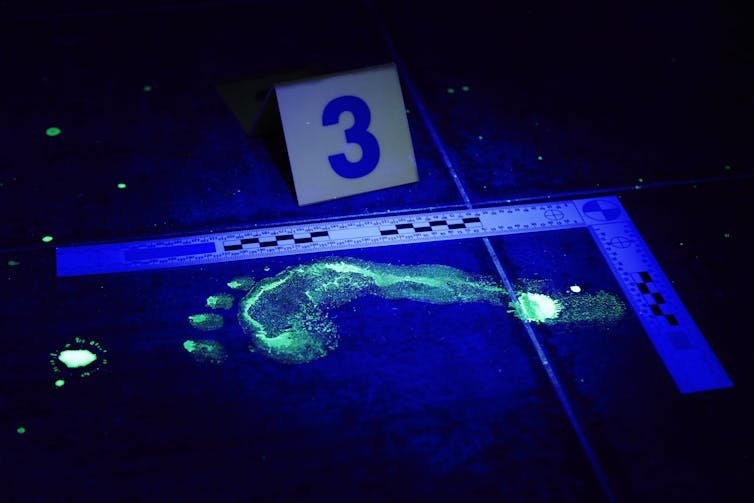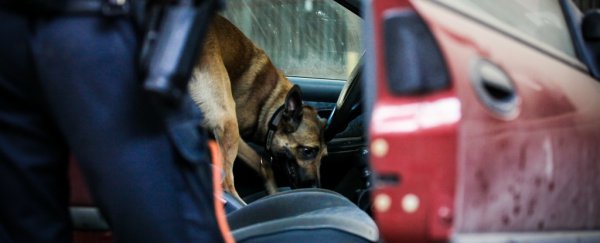It's difficult to contemplate the tragedy of losing a loved one and never knowing what happened to them.
Every year, an estimated 38,000 people go missing in Australia.
While almost 95 percent of these individuals are found relatively quickly, 5 percent become long-term missing persons cases, with many suspected victims of foul play.
British toddler Madeleine McCann disappeared in 2007 on a family holiday in Portugal, and has never been found. Sniffer dogs in this case initially assisted in locating blood samples found in the holiday home.
However, the use of canines has attracted controversy due to misunderstandings about the sensitivity of dogs to reliably find evidence through scent at a crime scene.
But our recent research shows that for sniffing out blood, dogs are one of the best investigative screening tools for expediting crime scene searches.
Blood is important evidence
Locating blood at a crime scene is a vital step. It can assist in recreating the events of a crime, identifying victims or suspects, establishing secondary crime scenes, ascertaining potential murder weapons, and in identifying links between individuals with locations and objects.
The police employ various testing methods when processing a crime scene for blood evidence. Colour and chemical change tests are applied to indicate the possible presence of blood.
A common example is luminol, which emits a bright blue colour (as seen below) when it reacts with haemoglobin (a molecule found in blood).
 Couperfield/shutterstock
Couperfield/shutterstock
If positive results are achieved, areas of interest are then targeted for further processing with more specific tests to confirm the presence of human blood.
But the smell of blood can also be used to locate it at crime scenes. In recent years, several law enforcement agencies in Europe and Australia have introduced blood-detection dogs, which are trained specifically for blood evidence.
By using this distinct dog unit, a large search area can be screened as a potential crime scene in cases of assault, missing persons, mass disasters or suspected homicides where a body may not be present.
Blood-detection dogs are a recently specialised unit under a broader grouping of scent-detection dogs used by law enforcement.
The dogs' highly sensitive sense of smell can locate a range of target odours including drugs, explosives, human bodies (known as "cadavers") and now blood.
The odour of death
Forensic odour profiling aims to unravel the chemical components of odour. Our research in this area focuses on the individual odour-producing constituents of blood, and explore how environmental changes can affect the ability of blood-detection dogs to detect these.
A scientific analysis of scent involves collecting the gases emitted from blood samples, and then separating the gaseous odour molecules (known as volatile organic compounds) to be individually detected and identified at trace levels.
Often searches are carried out a considerable time after the crime occurred. So in our first studies we compared the odour of fresh and degraded blood, chemically profiled over a two-year study and presented to cadaver-detection and blood-detection dogs in training.
Degraded blood is defined as blood which has undergone decomposition through the breakdown of cellular material.
Preliminary results indicate that a distinct odour change occurs from blood collected within 48 hours to degraded, with the odour profile changing throughout the degradation process.
Impressively, the canines which were mostly trained on fresh blood could locate blood confidently up to six months old, and had the ability to locate blood even as old as 24 months.
We've also established through this research that the surface on which the blood is deposited affects the odour produced by the blood.
Blood left on porous surfaces (such as clothing) and blood on non-porous surfaces (such as metallic objects) produce unique odour profile patterns which are most apparent when the blood is freshly deposited.
It's important that blood-detection dogs are trained to reliably locate blood on any type of crime scene surface they could potentially encounter on the job.
Blood is blood
A comparison of blood donors has also expanded our understanding of what human blood actually smells like: we refer to this as the "core odour profile of blood".
Although much of the odour profile is consistent from individual to individual, some variations do occur linked with differing lifestyle, diet, health and other factors in the environment.
However, early results suggests this may have little effect on the canine's ability to locate fresh and degraded blood from different people.
We also compared the sensitivity of detecting latent blood – that is, blood that is invisible to the naked eye – by dogs as compared to other methods such as luminol.
We created an artificial scenario in which a suspect attempted to remove a victim's blood from clothing by washing it five times.
Initial results indicate that the blood-detection and cadaver-detection dogs are much more sensitive than our current analytical detection approaches, but complementary to the use of luminol.
What happens to bodies after death
Our research into blood-detection by dogs is part of a broader program in forensic odour profiling and the science of body decomposition.
The first Australian Facility for Taphonomic Experimental Research (or AFTER) is now established.
Collaborating with 13 partner organisations, ongoing research at this facility strengthens our understanding of how the human body decomposes, and ultimately will assist investigators in the search for human remains.
By investigating the odour profile of common training aids utilised by law enforcement we can provide important recommendations for the training of blood-detection and cadaver-detection dogs to ensure their success in the field.
![]() Establishing a connection between science and law enforcement, we work hand in paw to provide justice for victims and bring closure for their families.
Establishing a connection between science and law enforcement, we work hand in paw to provide justice for victims and bring closure for their families.
LaTara Rust, PhD candidate, University of Technology Sydney and Shari Forbes, Professor, University of Technology Sydney.
This article was originally published by The Conversation. Read the original article.
UTS Science is a sponsor of ScienceAlert. Find out more about their research.
